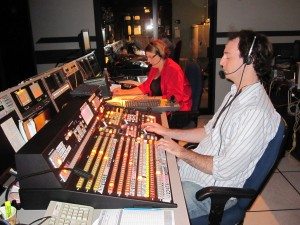By Michael Castengera, University of Georgia
 Increase efficiency. Improve morale. Reduce turnover. Raise the ratings. How, you ask? One word – communication. Yes, I know that sounds like a trite answer, but a professor at the University of Miami has done a survey that ‘proves’ just that.
Increase efficiency. Improve morale. Reduce turnover. Raise the ratings. How, you ask? One word – communication. Yes, I know that sounds like a trite answer, but a professor at the University of Miami has done a survey that ‘proves’ just that.
Terry Adams at the University’s School of Communication surveyed producers and directors in various markets around the country. Part of what she found out, anybody who has been in a television newsroom knows. Most directors are older males who have been at the same station for a long time while most producers are young females who have only been at the station for a couple of years.
Interestingly, although not surprisingly, the producers had a generally positive view of the directors with nearly all of the producers (97%) saying the director helped the process and nearly as many (88%) saying the director provided the information necessary and four-fifths (80%) rating the director as “competent.” It wasn’t quite the opposite with directors, but it was substantially different, with less than half (48%) of the directors agreeing that the producer helped in the process, and only slightly more (54%) saying the producer provided all the information necessary and nearly half (46%) of the directors rating the producer as “incompetent.”
Even more interesting and the key take-away from the survey (at least, to me) was Adams’ finding that there was a “significant relationship” between whether producers and directors held a show meeting and how they assessed each other’s competence. Those who held show meetings were more likely to consider their counterpart either the best they had worked with or at least competent.
And it gets even more interesting. Adams found that the “quality of information” the producers and/or directors received from their counterpart was “significantly correlated” to their overall job satisfaction. That, in turn, also showed a relationship to job turnover which Adams rightly noted is a major problem with producers. And both defined the “perfect” producer or director in terms of communication.
Finally, the piece de resistance, the stations with the highest reported levels of communication also had the highest ratings. In academic speak, Adams says, “correlation analysis shows ratings to be significantly related to the amount of information relayed.” To her credit, she also put it in plain English: “simply put, companies can make money out of good communication.”
YET… yet… (do you detect a note of frustration?), three quarters of the producers (75.9%) and directors (73%) did not have regular daily show meetings. And most (68%) work in different parts of the building so any ad hoc communication is impossible. Directors are less likely to take part in meetings in the news department than the other way around. Adams says the key finding is that not only do producers and directors not communicate well, they don’t even communicate minimally although, as she rightfully notes, “One cannot succeed without the other’s participation and involvement.”
And that note of frustration? That’s the consultant in me. I have recommended at EVERY station I have either worked at or consulted that the director be part of the editorial meeting. And there are always excuses why the director can’t do it.
Michael Castengera teaches broadcast news writing and production at the University of Georgia. He writes the weekly MfM (Message from Michael) newsletter, from which this article is excerpted. Contact him at Michael@MediaConsultant.tv








